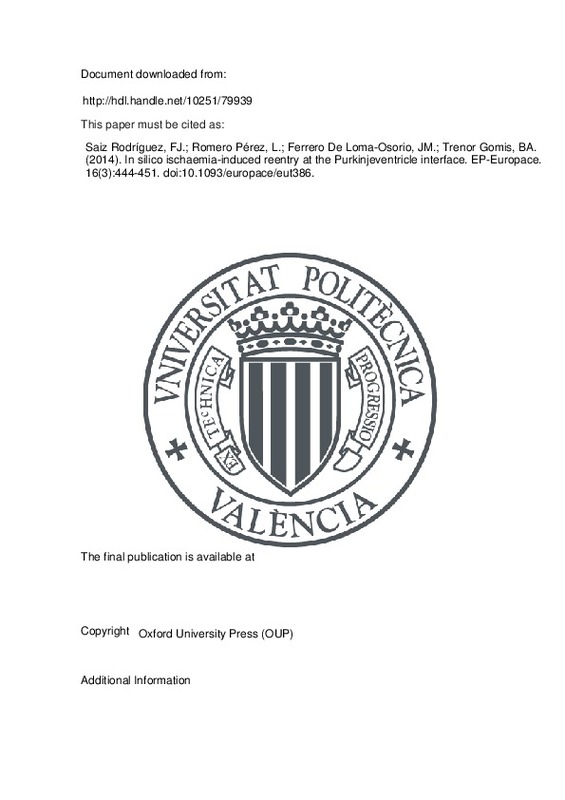JavaScript is disabled for your browser. Some features of this site may not work without it.
Buscar en RiuNet
Listar
Mi cuenta
Estadísticas
Ayuda RiuNet
Admin. UPV
In silico ischaemia-induced reentry at the Purkinjeventricle interface
Mostrar el registro sencillo del ítem
Ficheros en el ítem
| dc.contributor.author | Esteban Ramírez, Javier
|
es_ES |
| dc.contributor.author | Saiz Rodríguez, Francisco Javier
|
es_ES |
| dc.contributor.author | Romero Pérez, Lucia
|
es_ES |
| dc.contributor.author | Ferrero De Loma-Osorio, José María
|
es_ES |
| dc.contributor.author | Trénor Gomis, Beatriz Ana
|
|
| dc.date.accessioned | 2017-04-25T12:31:51Z | |
| dc.date.available | 2017-04-25T12:31:51Z | |
| dc.date.issued | 2014-03 | |
| dc.identifier.issn | 1099-5129 | |
| dc.identifier.uri | http://hdl.handle.net/10251/79939 | |
| dc.description.abstract | This computational modelling work illustrates the influence of hyperkalaemia and electrical uncoupling induced by defined ischaemia on action potential (AP) propagation and the incidence of reentry at the Purkinjeventricle interface in mammalian hearts. Unidimensional and bidimensional models of the Purkinjeventricle subsystem, including ischaemic conditions (defined as phase 1B) in the ventricle and an ischaemic border zone, were developed by altering several important electrophysiological parameters of the LuoRudy AP model of the ventricular myocyte. Purkinje electrical activity was modelled using the equations of DiFrancesco and Noble. Our study suggests that an extracellular potassium concentration [K](o) 14 mM and a slight decrease in intercellular coupling induced by ischaemia in ventricle can cause conduction block from Purkinje to ventricle. Under these conditions, propagation from ventricle to Purkinje is possible. Thus, unidirectional block (UDB) and reentry can result. When conditions of UDB are met, retrograde propagation with a long delay (320 ms) may re-excite Purkinje cells, and give rise to a reentrant pathway. This induced reentry may be the origin of arrhythmias observed in phase 1B ischaemia. In a defined setting of ischaemia (phase 1B), a small amount of uncoupling between ventricular cells, as well as between Purkinje and ventricular tissue, may induce UDBs and reentry. Hyperkalaemia is also confirmed to be an important factor in the genesis of reentrant rhythms, since it regulates the range of coupling in which UDBs may be induced. | es_ES |
| dc.description.sponsorship | This work was supported: (i) by the European Commission preDiCT grant (DG-INFSO-224381), (ii) by the 'VI Plan Nacional de Investigacion Cientifica, Desarrollo e Innovacion Tecnologica' from the Ministerio de Economia y Competitividad of Spain (grant number TIN2012-37546-C03-01) and the European Commission (European Regional Development Funds - ERDF - FEDER), and (iii) by the Programa de Apoyo a la Investigacioon y Desarrollo (PAID-06-11-2002) de la Universidad Politecnica de Valencia, Programa Prometeo (PROMETEO/2012/030) de la Conselleria d'Educacio Formacio I Ocupacio, Generalitat Valenciana, and (iv) Direccion General de Politica Cientifica de la Generalitat Valenciana (GV/2013/119). | en_EN |
| dc.language | Inglés | es_ES |
| dc.publisher | Oxford University Press (OUP) | es_ES |
| dc.relation | European Commission preDiCT grant DG-INFSO-224381 | es_ES |
| dc.relation.ispartof | EP-Europace | es_ES |
| dc.rights | Reserva de todos los derechos | es_ES |
| dc.subject | Arrhythmias | es_ES |
| dc.subject | Computer simulations | es_ES |
| dc.subject | Hyperkalaemia | es_ES |
| dc.subject | Intercellular coupling | es_ES |
| dc.subject | Phase 1B ischaemia | es_ES |
| dc.subject | Reentry | es_ES |
| dc.subject.classification | TECNOLOGIA ELECTRONICA | es_ES |
| dc.title | In silico ischaemia-induced reentry at the Purkinjeventricle interface | es_ES |
| dc.type | Artículo | es_ES |
| dc.identifier.doi | 10.1093/europace/eut386 | |
| dc.relation.projectID | info:eu-repo/grantAgreement/EC/FP7/224381/EU/Computational Prediction of Drug Cardiac Toxicity/ | en_EN |
| dc.relation.projectID | info:eu-repo/grantAgreement/MINECO//TIN2012-37546-C03-01/ES/CORAZON HUMANO COMPLETO FISIOLOGICO VIRTUAL: MEJORAS EN EL TRATAMIENTO DE ARRITMIAS CARDIACAS ORIENTADO A PACIENTE/ | es_ES |
| dc.relation.projectID | info:eu-repo/grantAgreement/UPV//PAID-06-11-2002/ | es_ES |
| dc.relation.projectID | info:eu-repo/grantAgreement/GVA//PROMETEO%2F2012%2F030/ES/MEJORA EN LA PREVENCION Y TRATAMIENTO DE PATOLOGIAS CARDIACAS A TRAVES DE LA MODELIZACION MULTI-ESCALA Y LA SIMULACION COMPUTACIONAL (DIGITAL HEART)/ | es_ES |
| dc.relation.projectID | info:eu-repo/grantAgreement/GVA//GV%2F2013%2F119/ | es_ES |
| dc.rights.accessRights | Abierto | es_ES |
| dc.contributor.affiliation | Universitat Politècnica de València. Escuela Técnica Superior de Ingenieros Industriales - Escola Tècnica Superior d'Enginyers Industrials | es_ES |
| dc.contributor.affiliation | Universitat Politècnica de València. Escuela Técnica Superior de Ingeniería del Diseño - Escola Tècnica Superior d'Enginyeria del Disseny | es_ES |
| dc.description.bibliographicCitation | Esteban Ramírez, J.; Saiz Rodríguez, FJ.; Romero Pérez, L.; Ferrero De Loma-Osorio, JM.; Trénor Gomis, BA. (2014). In silico ischaemia-induced reentry at the Purkinjeventricle interface. EP-Europace. 16(3):444-451. https://doi.org/10.1093/europace/eut386 | es_ES |
| dc.description.accrualMethod | S | es_ES |
| dc.relation.publisherversion | http://dx.doi.org/10.1093/europace/eut386 | |
| dc.description.upvformatpinicio | 444 | es_ES |
| dc.description.upvformatpfin | 451 | es_ES |
| dc.type.version | info:eu-repo/semantics/publishedVersion | es_ES |
| dc.description.volume | 16 | es_ES |
| dc.description.issue | 3 | es_ES |
| dc.relation.senia | 259533 | es_ES |
| dc.identifier.eissn | 1532-2092 | |
| dc.contributor.funder | Universitat Politècnica de València | es_ES |
| dc.contributor.funder | Ministerio de Economía y Competitividad | es_ES |
| dc.contributor.funder | Generalitat Valenciana | es_ES |
| dc.contributor.funder | European Regional Development Fund | es_ES |







![[Cerrado]](/themes/UPV/images/candado.png)

